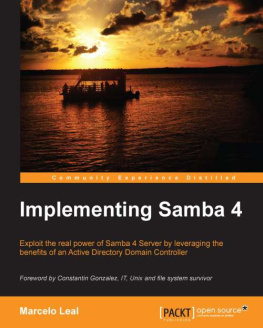Leal - Implementing Samba 4
Here you can read online Leal - Implementing Samba 4 full text of the book (entire story) in english for free. Download pdf and epub, get meaning, cover and reviews about this ebook. City: Birmingham;England, year: 2014, publisher: Packt Publishing, genre: Home and family. Description of the work, (preface) as well as reviews are available. Best literature library LitArk.com created for fans of good reading and offers a wide selection of genres:
Romance novel
Science fiction
Adventure
Detective
Science
History
Home and family
Prose
Art
Politics
Computer
Non-fiction
Religion
Business
Children
Humor
Choose a favorite category and find really read worthwhile books. Enjoy immersion in the world of imagination, feel the emotions of the characters or learn something new for yourself, make an fascinating discovery.
- Book:Implementing Samba 4
- Author:
- Publisher:Packt Publishing
- Genre:
- Year:2014
- City:Birmingham;England
- Rating:3 / 5
- Favourites:Add to favourites
- Your mark:
- 60
- 1
- 2
- 3
- 4
- 5
Implementing Samba 4: summary, description and annotation
We offer to read an annotation, description, summary or preface (depends on what the author of the book "Implementing Samba 4" wrote himself). If you haven't found the necessary information about the book — write in the comments, we will try to find it.
Leal: author's other books
Who wrote Implementing Samba 4? Find out the surname, the name of the author of the book and a list of all author's works by series.
Implementing Samba 4 — read online for free the complete book (whole text) full work
Below is the text of the book, divided by pages. System saving the place of the last page read, allows you to conveniently read the book "Implementing Samba 4" online for free, without having to search again every time where you left off. Put a bookmark, and you can go to the page where you finished reading at any time.
Font size:
Interval:
Bookmark:
Copyright 2014 Packt Publishing
All rights reserved. No part of this book may be reproduced, stored in a retrieval system, or transmitted in any form or by any means, without the prior written permission of the publisher, except in the case of brief quotations embedded in critical articles or reviews.
Every effort has been made in the preparation of this book to ensure the accuracy of the information presented. However, the information contained in this book is sold without warranty, either express or implied. Neither the author, nor Packt Publishing, and its dealers and distributors will be held liable for any damages caused or alleged to be caused directly or indirectly by this book.
Packt Publishing has endeavored to provide trademark information about all of the companies and products mentioned in this book by the appropriate use of capitals. However, Packt Publishing cannot guarantee the accuracy of this information.
First published: April 2014
Production Reference: 1310314
Published by Packt Publishing Ltd.
Livery Place
35 Livery Street
Birmingham B3 2PB, UK.
ISBN 978-1-78216-658-0
www.packtpub.com
Cover Image by Marcelo Leal (<>)
Author
Marcelo Leal
Reviewers
Kai Blin
Henry Gultom
Iulian-Nicu erbnoiu
Manikandan Somasundaram
Acquisition Editors
Akram Hussain
Nikhil Karkal
Content Development Editor
Athira Laji
Technical Editors
Manan Badani
Shali Sasidharan
Copy Editors
Tanvi Gaitonde
Aditya Nair
Stuti Srivastava
Project Coordinator
Sanghamitra Deb
Proofreaders
Mario Cecere
Maria Gould
Clyde Jenkins
Indexer
Monica Ajmera Mehta
Graphics
Sheetal Aute
Disha Haria
Yuvraj Mannari
Production Coordinator
Nilesh Bambardekar
Cover Work
Nilesh Bambardekar
Shared, networked file and print services are the heart and blood of any office environment. They allow users of a network to store their files reliably, share them with each other, and bridge the gap between multiple places of work, multiple devices and tools, and multiple operating systems.
The latter aspect is key to a modern work environment: integrating the worlds of Unix/Linux and Mac OS X with the traditional Windows PC environment not only allows users of a "foreign" OS to collaborate in a Windows-dominated world, it also enables Windows environments to benefit from the power of Unix/Linux server environments with advanced networking, high availability, backup/recovery, and automation capabilities as well as integration with enterprise-class infrastructure and tools.
When Andrew Tridgell implemented the first version of Samba in 1991, he probably did not foresee the tremendous impact that his software would have on today's office productivity environments and the role it would fill as the bridge between two worlds that couldn't be more different from each other. Yet, this is exactly what makes Samba so fascinating: the power to integrate the Windows world with the Unix/Linux/Mac OS X world, the Rosetta Stone of filesystem protocols.
Wielding this power can be difficult and complicated. In today's hectic world of IT system administration, the pressure to deliver a robust, stable, highly available, and dependable infrastructure at a low cost has never been greater. Modern system administrators frequently don't have the time or training to understand every possible aspect of any given software, especially if it is a complex system that has grown over several decades. They need simple, practical, relevant advice on how to accomplish their day-to-day tasks, enabling them to get the basics of file and print services up and running. They need to do so quickly and efficiently, so they can concentrate on higher-level tasks, knowing that the key underlying infrastructure is in place and running reliably.
I'm very happy to see that Marcelo has accepted the challenge of boiling down heaps of documentation, white papers, and other collateral into a single, concise, practical guide to implementing Samba 4. Marcelo draws from over a decade of experience in running large-scale IT projects, from high-level planning to the nitty-gritty details of command-line options and complex troubleshooting.
And the result is a clear, concise, extremely useful step-by-step guide on how to set up your Samba 4 environment: from basic installation to AD Domain Controller setup and management, migration from an existing Windows server environment, upgrading from Samba 3, running file and print services, LDAP, clustering, and of course scripting. This guide has got you covered.
Of course, no guide can replace the full documentation or address the intricacies of every single corner case. But staying true to the Pareto principle, this is exactly the 20 percent of documentation that you need to read to get 80 percent of your Samba 4 work done. With Marcelo's expertise boiled down into a single book, you can get up and running quickly, then concentrate your energy into those aspects of your installation that are unique to your environment and that warrant your special attention.
IT system administrators often have an aura of "IT wizards" around them, as if they had the power to "heal" a broken computer with the touch of a hand. This "magic" really stems from decades of experience; hard-learned intuition; and the tedious, day-to-day work of getting IT stuff done. I hope that the "virtual Marcelo" distilled into this book can help you become such a "Samba wizard", enabling you to ensure that your organization's productivity is covered, at least from a file and print perspective.
Constantin Gonzalez
IT, Unix and file system survivor
Marcelo Leal studied at Unisinos, where he undertook a Bachelor's degree in Computing Science. Having worked in the IT industry for more than 15 years, he has gained experience as a network/system administrator, support manager, Unix/Linux specialist, storage architect, and most recently, as a solutions architect. He was involved in open source projects since the beginning of his career and has developed some open source tools and submitted patches to the GNU/Linux and FreeBSD kernel. In 2005, he was honored for his participation in the Prmio TI e Governo for the project "Metrpole", Porto Alegre/RS. He was one of the founders of the Porto Alegre OpenSolaris User Group (PoaOSUG) and was a contributor for the Open High Availability Cluster Community (OHAC) within the OpenSolaris Project; he was the first person outside Sun Microsystems to contribute code to the Open Cluster software. He received three prizes at the OpenSolaris innovation awards program (2007-2008), and presented a solution for Storage High Availability using nonshared disks at the first OHAC Summit in San Francisco/California, USA (2009). In 2013, he presented a highly available, scalable, and high performance three-layer storage solution at SNIA SpeedConf, Santa Clara/California, USA, which, besides adding a lot of value to the storage service, provided huge savings in capex and opex costs (millions of dollars in three years). He has led the architecture and development of a distributed Storage Appliance that, in three years, provided more than 1.5 million operations per second (CIFS, NFS, and iSCSI) for almost 10PB in an area available for a diverse range of products. In 2010, he wrote
Font size:
Interval:
Bookmark:
Similar books «Implementing Samba 4»
Look at similar books to Implementing Samba 4. We have selected literature similar in name and meaning in the hope of providing readers with more options to find new, interesting, not yet read works.
Discussion, reviews of the book Implementing Samba 4 and just readers' own opinions. Leave your comments, write what you think about the work, its meaning or the main characters. Specify what exactly you liked and what you didn't like, and why you think so.








